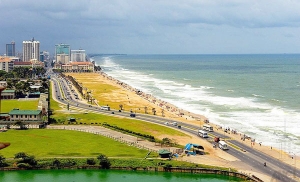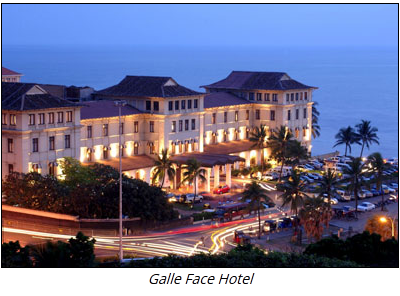
Wednesday, 25th June 2014

By Anthony Dennis
When builders set about restoring the original 150-year-old heritage wing of Colombo's classic Galle Face Hotel they made a fascinating, if not ever so slightly salacious, discovery. On the bottom of a bedside table drawer in one of the suites, an Englishman and a Frenchwoman had penned a message, a titillating time capsule, detailing a torrid four days they had spent in 1944 mainly locked in their room in flagrante.
Fast-forward 70 years. I'm booked into a spacious, timbered and marbled spa suite of the Galle Face Hotel, the waves from the Indian Ocean crashing rousingly below me, for a couple of nights. Sadly, perhaps, I'm resolutely alone, with nothing of even a vaguely illicit note to report.
Yet, even today, places such as Colombo, and colonial hotels such as the Galle Face that seem to ooze romance and nostalgia from their floorboards, still tend to fire the emotions, especially as Sri Lanka's largest city emerges from the three decades of civil war that rendered it a backwater. The security barriers around public buildings in the central Fort area have mostly come down, and the heavy military presence of the past has been eased.
The wildly overdue restoration of the Galle Face Hotel, which is this year celebrating its sesquicentenary, is part of a wider revival of a city worn out and worn down by three decades of bitter conflict. Now, with a permanent peace Colombo is rising again, gradually mounting a case for the status of Asia's next great city.
International hotel brands such as Shangri-la and Hyatt are poised to open properties and challenge the status of the Galle Face as the preferred address for visitors to the city. In a new plan for Colombo, the government has borrowed heavily from the World Bank to fund a beautification scheme for the capital, as well as improvements to its ramshackle drainage and sewerage system.
Colonial buildings
Down the coast from the Galle Face Hotel, an expanded, modern port, built with the assistance of the Chinese, is emerging, as well as the reclaimed foundations for a flashy Port City, a mini Dubai of sorts. Sri Lanka's first freeways - to the airport and to popular Galle in the south - have opened, again with the help of the Chinese, with intentions to build a new link to Kandy, Sri Lanka's second city and holy capital. Suddenly, a few days in Colombo on a Sri Lankan itinerary is starting to make sense.
 With the end of the war, the government has redeployed the military, lest its members be unemployed, into the restoration of the city's generous stock of colonial buildings, such as the 16th-century Old Dutch Hospital and the Auditor-General's Building from the 18th century, each intended to entice foreigners and wealthy locals to fashionable restaurants, cafes and shops. Then there's the rather bold plan for a complex by noted Australian entrepreneur and amateur pugilist James Packer, waiting to be built on a tight site beside Beira Lake. Since the end of the war, Sri Lanka's economy has been enjoying China-like growth rates, with its per capita income ahead of counterpart economies in South Asia.
With the end of the war, the government has redeployed the military, lest its members be unemployed, into the restoration of the city's generous stock of colonial buildings, such as the 16th-century Old Dutch Hospital and the Auditor-General's Building from the 18th century, each intended to entice foreigners and wealthy locals to fashionable restaurants, cafes and shops. Then there's the rather bold plan for a complex by noted Australian entrepreneur and amateur pugilist James Packer, waiting to be built on a tight site beside Beira Lake. Since the end of the war, Sri Lanka's economy has been enjoying China-like growth rates, with its per capita income ahead of counterpart economies in South Asia.
An essential Colombo experience is sun-downers at the seaside Terrace Bar at the Galle Face Hotel. Out to sea the outline of a distant tanker, emitting a sharp white light in the gloom, is teetering on the horizon. A bank of steely storm clouds is advancing towards Colombo, threatening to deny the assembled, including me, a glimpse of the setting sun over the Indian Ocean.
There's a noticeably sharp enervating rise in the humidity as the waiter pops a lantern on the table beside my local Lion beer, just as some blushing puffs of pink somehow emerge from the dark clouds, which deliver a crack of lightning and a clap of thunder that momentarily muffles the sound of the waves careering into the seawall below the Terrace Bar.
But the truth is that to linger a little longer now is to witness the re-emergence of a once great colonial city and once essential stop on voyages to and from Europe.
"Colombo is a whole new city," says Galle-based author Juliet Coombe.
Glamorous place
"It's becoming a very glamorous place. It's not like Bangkok, because you can still get around, and there are new restaurants, new designers, new boutiques, new hotels. There's a real will to make it a great city again. A decade ago Colombo was considered the worst city in Asia, but it's been transformed. Before, people wanted to avoid it, but now they want to embrace it."
One afternoon, I take a packed commuter train from Colombo's adorably primitive Fort Railway Station to Mount Lavinia for a visit to the less-than-secret eponymous hotel, a largely unrenovated but well-maintained, whitewashed relic of British colonial times. It served as a hospital in one of the key scenes of David Lean's The Bridge on the River Kwai, which was shot in Sri Lanka, or Ceylon as it was then known. From here you can see all the way down the coast back to the Galle Face Hotel and the massive cranes of the port.
It'll be a decade in December since the tsunami, and it's sobering to learn from my expatriate train companion that the tsunami, which killed a biblical 50,000 Sri Lankans, came as close as 13 kilometres to Colombo. The track hugs the coastline as we jiggle and jangle from the rocking of the train. A middle-aged Sri Lankan man standing next to me overhears our conversation about the country's emergence from war. As the train clatters along, he speaks movingly of the suffering of his country and the constant spectre of bombings by the Tamil Tigers. "It was terrible," he says. "No one wanted to take the train or the bus out of fear from explosions. But now we have hope for the future." On my last night in Colombo, and Sri Lanka, I decide to take a sunset stroll along the length of the city's famous Galle Face Green, created by the Dutch colonisers who left it clear to provide an unobstructed line of fire against aggressors. It's a piece of prime real estate, and I wonder whether it will stay in public hands before the developers get their hands on it, travesty that it would be.
Colombo's remarkable comeback
This public space is so well-patronised that the well-worn grass, from which the green takes its name, is fighting a losing battle with the patches of exposed sand. It's sunset. The inevitable cricket games are under way, paper kites swooping and diving above them, played in between clusters of Tamil schoolgirls wearing flowing cotton hijabs dyed mauve, on some kind of excursion.
As I stroll along, the sun seemingly weakening with every step, the Galle Face Hotel in the fuzzy distance, I wonder whether these crowds would have been so carefree when the war was still on, for fear of suicide bombers, the last bomb having been detonated some years ago. (During the war, I'm told, there were nearly 400 of them, many in Colombo). But, against the background of the city's nascent high-rise skyline and with the nation's various racial and religious groups at play together, there is a palpable sense of optimism, once a rare commodity in Sri Lanka. I almost feel like scratching a message, just like that amorous couple, marking this point in Colombo's remarkable comeback, underneath the drawer of my own hotel bedside table.
Anthony Dennis is Fairfax Media's national travel editor. He travelled as guest of the Classic Safari Company and with the assistance of Singapore Airlines.
Courtesy: The Sydney Morning Herald
From : http://www.dailynews.lk/?q=features/sri-lanka-china-growth




